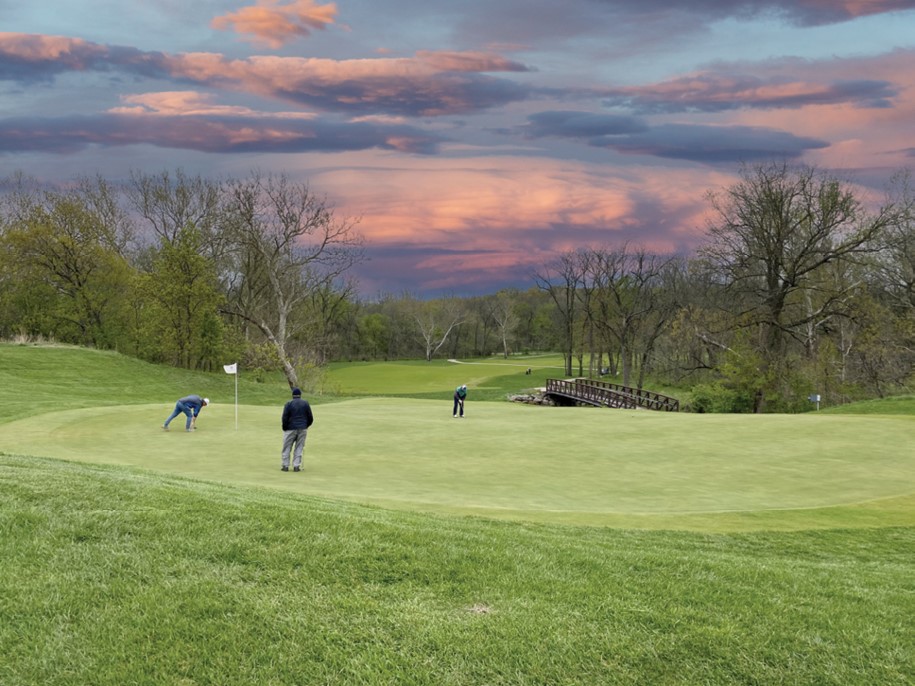
Astonishing play numbers and tight maintenance windows are all Doug Melchior knows. A Kansan since age 5, Melchior worked a pair of college internships at Sykes/Lady Overland Park Golf Club while attending Kansas State University. Melchior steadily progressed through the City of Overland Park’s golf ranks and today serves as manager of golf and grounds. He oversees the maintenance of the city’s 54 holes.
Overland Park boasts the busiest golf operation in Kansas. The 27 regulation holes and 9-hole par-3 course at Sykes/Lady supported 115,000 rounds in a cool-weather environment in 2021, according to Melchior. The city’s other facility, nearby St. Andrews Golf Club, supported more than 60,000 rounds on its wooded layout, making it one of the more crowded 18-hole courses in the Midwest.
A quick drive through the St. Andrews maintenance facility with superintendent Marc Szablewski in early May revealed a giant outdoor recycling bin next to the sand bin filled nearly two-thirds of the way with used beverage (mainly beer) cans. On the same gloomy spring afternoon, with temperatures failing to leave the 40s, Sykes/Lady superintendent Tom Storey struggled finding a gap in play to show a visitor the massive greens his team maintains.
For Melchior and his team, it was just another day in Overland Park, where the parking lots aren’t always big enough to handle all the players, practicers, diners and drinkers, where the city’s golf eblasts reach more than 40,000 subscribers, and where 5,000 regular customers participate in the patron card program. “I only know one way,” Melchior says. “The OP way.”
Melchior relies on Szablewski and Storey, who have experience working elsewhere, to remind him that Overland Park represents a cool-weather golf anomaly. The trio leads a crew of around a dozen full-time employees preparing 54 holes for more than 1,000 players on ultra-busy days. Instead of chasing perfection, they are chasing completion. And their completed product is so good that Melchior, Szablewski and Storey play in the city’s weekly golf leagues.
The courses exist for a basic reason. “Our No. 1 goal is to provide recreation to our patrons and the citizens of Overland Park,” Melchior says. “We aren’t after green speeds of 12, 13, 14. We just want good, quality core conditions.” That philosophy makes Overland Park a terrific example of municipal golf success.
Sykes/Lady opened in 1971, one year before Overland Park unveiled St. Andrews. The city’s golf operation has existed entirely without subsidization. The operating budget hovers around $7 million for 54 holes and two clubhouses, including the trendy structure at Sykes/Lady with plentiful indoor and patio dining space and a sophisticated grab-and-go section. City officials had hoped for $800,000 in food and beverage revenue when they unveiled the new Sykes/Lady clubhouse in 2019, according to Melchior. The possibilities presented by a new clubhouse weren’t noticeable in 2020 because of COVID-19 interruptions. But the golf surge carried into 2021 and the clubhouse yielded $1.8 million in food and beverage revenue, with Melchior adding that the $2 million mark could be reached in 2022.
Producing a golf experience with a modest staff that entices customers to stick around for food and drinks isn’t for the timid. Peak-season play on the North, South and West nines at Sykes/Lady occurs in three waves, with the first one at 7:27 a.m., nearly two hours after Storey’s team begins its day. The second and third waves begin at 11:30 a.m. and 4 p.m., respectively. A frost delay means the first wave doesn’t happen.
“It’s organized chaos,” Storey says. “At that 7:30 mark, we are trying to get to our second jobs. I don’t think anybody thinks about it a whole lot. You move onto the next thing and go from there.”
Storey’s team is adept at working through play and everybody responsible for maintaining Overland Park’s golf turf doesn’t have time to fret over golfer-created issues because there are seemingly golfers everywhere all the time. “You see so much that you become numb to a lot of stuff that makes people upset,” Melchior says. “You see people driving close to the greens all the time. If you stop and talk to everyone, you wouldn’t get anything done.”
Sykes/Lady has a 300-acre footprint and holes on both sides of a busy road. The city owns another 190 acres at St. Andrews. So, how does everything get done?
Melchior says it begins with Szablewski and Storey. Formally, the superintendents and Melchior meet once per week. Informally, they are always chatting and supporting each other. Szablewski, a Kansas State alum, joined the Overland Park team in 2008 and became St. Andrews superintendent a decade later. Storey, a native Iowan, attended Iowa State and worked at several courses in his native state before moving to Overland Park.
“The dog days of summer become a challenge,” Melchior says. “That’s where the three of us are good co-workers, but we’ve become great friends. It can be 8 o’clock at night or 6 o’clock in the morning and I might get a phone call from one of them and they just need to rant and let it all out. It happens and that’s what we are here for.”
Those calls were frequent early in Storey’s tenure as superintendent at Sykes/Lady. “I was at an 18-hole course in Iowa where we were lucky to get 8,000 rounds a year,” he says. “I got hired in March here and we might have had 8,000 rounds in my first month.”
The unique relationship between the trio becomes apparent during a lunch conversation in the Sykes/Lady clubhouse.
Szablewski: “I would say I feel bad for Tom, but I worked here for nine years and know what this place is!”

Melchior: “Tom was a seasoned superintendent. We were really, really lucky to hire him. His first eight months here his head was spinning out of control, there were multiple times I would go to the shop and ask Marc, ‘Is he OK? Is he going to make it?’ because this place is a beast.”
Szablewski: “Tom and I had many conversations that we will probably keep to ourselves.”
Storey: “That first month I was real quiet.”
Storey is in his seventh season at Lady/Sykes and the underlying challenge of his job remains unchanged. “It doesn’t slow down here,” he says. “It never slows down.”
Melchior instills a down-the-middle maintenance philosophy. Flowers and landscape beds are almost non-existent except around the clubhouse. Greens, fairways and tees are the focus. Melchior describes the fertility programs as “higher” than most golf courses because of the significant cart traffic. Areas that fail to withstand the pounding are resodded. Greens on both courses are aerified in April and September. Nine greens are aerified per morning, with that nine reopening for league play at 4:03 p.m. The Overland Park team attempts to minimally aerify every fairway every other year, with at least half of the city’s fairways being completed each year.
Reliable equipment helps crews execute tasks ahead of play. The city decided in 2003 to put its golf maintenance equipment lease package out to bid every four years. The service component of the leases is vital because Overland Park doesn’t employ a golf equipment technician. “Our full-time staff isn’t as specialized as you normally would think of,” Melchior says. “We don’t have spray techs, we don’t have irrigation techs. All of our full-time staff are cross trained to do everything. Not one person is specialized, therefore we lease all of our equipment.”
Revenue the city generates from the courses goes back into the courses. Kansas City-based architect Todd Clark, who grew up playing golf in Overland Park, has guided projects to improve both courses, most notably quickly creating six new holes at St. Andrews in 2009 to replace six holes lost because of the construction of a community soccer complex. St. Andrews is finishing a multi-year bunker renovation. During the Sykes/Lady clubhouse project, Clark and his partner Brent Hugo crafted a plan to ensure safe and efficient golfer flow throughout construction. A bunker renovation at Sykes/Lady is also in the works.
Continued infrastructure improvements will likely ease the maintenance burden. But they also could make Lady/Sykes and St. Andrews even more popular.
“By the end of summer,” Szablewski says, “it’s one big blur. You’re like, ‘Thank God everything is still green.’”

Explore the August 2022 Issue
Check out more from this issue and find your next story to read.
Latest from Golf Course Industry
- From the publisher’s pen: Conscientious of a bigger role
- Bernhard and Company partners with Laguna Golf Phuket
- Terre Blanche showcases environmental stewardship
- VIDEO: Introducing our December issue
- Bernhard and Company introduces Soil Scout
- Nu-Pipe donates to GCSAA Foundation’s Centennial Campaign
- GCSAA enhances golf course BMP tool
- Melrose leadership programs sending 18 to 2026 GCSAA Conference and Trade Show





